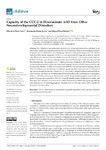Mostrar el registro sencillo del ítem
Capacity of the CCC-2 to Discriminate ASD from Other Neurodevelopmental Disorders
| dc.contributor.author | Durán-Bouza, Montserrat | |
| dc.contributor.author | Pérez-Pereira, Miguel | |
| dc.contributor.author | De la Torre Carril, Alba | |
| dc.date.accessioned | 2022-01-27T13:19:00Z | |
| dc.date.available | 2022-01-27T13:19:00Z | |
| dc.date.issued | 2021 | |
| dc.identifier.citation | De la Torre Carril, A.; Durán-Bouza, M.; Pérez-Pereira, M. Capacity of the CCC-2 to Discriminate ASD from Other Neurodevelopmental Disorders. Children 2021, 8, 640. https://doi.org/10.3390/children8080640 | es_ES |
| dc.identifier.uri | http://hdl.handle.net/2183/29504 | |
| dc.description | This article belongs to the Special Issue Screening, Diagnosis and Early Intervention in Toddlers with Autism Spectrum Disorders | es_ES |
| dc.description.abstract | [Abstract] The Children’s Communication Checklist (CCC-2) has demonstrated its usefulness as an instrument to assess discrepancies between the use of structural dimensions of language and the pragmatic and sociointeractive uses of language. The aims of the present paper are: (1) to test the capacity of the Galician adaptation of the CCC-2 to discriminate the linguistic profiles of children with different disorders and (2) to test whether the capacity of the CCC-2 to discriminate the linguistic abilities of children with different disorders is the same at different ages: earlier development and later development. The sample is of 117 children previously diagnosed with different disorders: autism spectrum disorder (ASD), developmental language disorder (DLD), attention deficit with hyperactivity disorder (ADHD), Down syndrome children (DS) and typically developing children (TD). The children were divided into two different age groups: from 4 to 6 and from 7 to 16 years of age. The results indicate that the Galician CCC-2 (1) accurately identified children with and without communicative impairments, (2) distinguished between profiles with a predominance of pragmatic (ASD and ADHD) and structural disorders (DS and DLD) and (3) distinguished between different profiles of pragmatic impairment. The CCC-2 equally identified these profiles at both earlier and later ages. The Galician CCC-2 seems to be a useful instrument for differentiating among different clinical groups and for assessing pragmatic disorders from an early age, which can be valuable for planning early intervention. | es_ES |
| dc.language.iso | eng | es_ES |
| dc.relation.uri | https://doi.org/10.3390/children8080640 | es_ES |
| dc.rights | Atribución 4.0 Internacional | es_ES |
| dc.rights.uri | http://creativecommons.org/licenses/by/3.0/es/ | * |
| dc.subject | CCC-2 | es_ES |
| dc.subject | Communicative impairments | es_ES |
| dc.subject | Pragmatic disorders | es_ES |
| dc.subject | Autism spectrum disorder | es_ES |
| dc.subject | Neurodevelopmental disorders | es_ES |
| dc.title | Capacity of the CCC-2 to Discriminate ASD from Other Neurodevelopmental Disorders | es_ES |
| dc.type | journal article | es_ES |
| dc.rights.accessRights | open access | es_ES |
| UDC.journalTitle | Children | es_ES |
| UDC.volume | 8 | es_ES |
| UDC.issue | 8 | es_ES |
| UDC.startPage | 640 | es_ES |
| dc.identifier.doi | 10.3390/children8080640 | |
| UDC.coleccion | Investigación | es_ES |
| UDC.departamento | Psicoloxía | es_ES |
| UDC.grupoInv | Grupo de Investigación en Psicoloxía do Desenvolvemento e da Aprendizaxe Escolar (GIPDAE) | es_ES |
Ficheros en el ítem
Este ítem aparece en la(s) siguiente(s) colección(ones)
-
Investigación (FEDU) [938]






